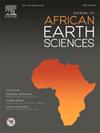Geochemical approach to depositional setting and organic matter accumulation of lower cretaceous shales of the Mundeck formation, Kribi-Campo sub-basin (South Cameroon)
IF 2.2
4区 地球科学
Q2 GEOSCIENCES, MULTIDISCIPLINARY
引用次数: 0
Abstract
In order to deduce the origin, depositional setting and factors of organic matter accumulation, the Kribi Campo shales were examined for total organic carbon and geochemical analysis. The results show that the average total organic carbon concentration in the six studied sites are greater than 1 (3.58–12.26 w. %), suggesting they are good source rocks. The studied shales reveal V/Ni values of 1.88–4.26 indicating that the organic matter in the shales were sourced from marine origin and mixed terrestrial marine origin. The Al, Zr and Zr/Al diagrams, indicate that the terrigenous debris influx was relatively high in the Lower Formation and fluctuates from relatively constant to relatively decreasing and increasing manner in the Upper Formation. The Ni/Co, V/Cr, U/Th ratios range from 1.39 to 3.21, 1.22–1.81, 0.18–0.45 respectively, and an average Y/Ho ratio of 26.37–28.71 ppm, indicate the shales were deposited in a continental environment. The paleoproductivity proxies (P/Ti, Babio, Cu/Al, and Ni/Al), shows that in both Formation the P/Ti average ratio value (0.27 and 0.29), indicates moderate rate of paleoproductivity. Babio average concentration in the studied sites of the Upper Mundeck Formation is higher than that of the Lower Mundeck Formation, indicating the authigenic barium sulfate was stored in variable quantities in the different studied sites of both Formations, its values vary from 322.94 to 2335.22 ppm, indicates a low to moderate paleoproductivity. The organic matter was preserved as a result of rapid deposition, high sedimentation and lesser exposure time.
南喀麦隆Kribi-Campo次盆地Mundeck组下白垩统页岩沉积环境及有机质聚集的地球化学研究
为了推断克里比坎波页岩的成因、沉积背景和有机质成藏因素,对克里比坎波页岩进行了总有机碳和地球化学分析。结果表明,6个研究地点的平均总有机碳浓度均大于1 (3.58 ~ 12.26 w. %),为较好的烃源岩。研究页岩的V/Ni值为1.88 ~ 4.26,表明页岩有机质来源为海相和陆相混合。Al、Zr和Zr/Al图表明,下组陆源碎屑流相对较高,上组陆源碎屑流由相对恒定向相对减小和增大方向波动。Ni/Co、V/Cr、U/Th比值分别为1.39 ~ 3.21、1.22 ~ 1.81、0.18 ~ 0.45,平均Y/Ho比值为26.37 ~ 28.71 ppm,表明页岩沉积环境为陆相环境。古生产力指标(P/Ti、Babio、Cu/Al和Ni/Al)表明,两组的P/Ti平均值分别为0.27和0.29,表明古生产力处于中等水平。上蒙德克组研究地点的巴比奥平均浓度高于下蒙德克组,表明自生硫酸钡在两组不同研究地点的储存量不同,其值在322.94 ~ 2335.22 ppm之间,表明古生产力处于低至中等水平。由于快速沉积、高沉降和较短的暴露时间,有机质得以保存。
本文章由计算机程序翻译,如有差异,请以英文原文为准。
求助全文
约1分钟内获得全文
求助全文
来源期刊

Journal of African Earth Sciences
地学-地球科学综合
CiteScore
4.70
自引率
4.30%
发文量
240
审稿时长
12 months
期刊介绍:
The Journal of African Earth Sciences sees itself as the prime geological journal for all aspects of the Earth Sciences about the African plate. Papers dealing with peripheral areas are welcome if they demonstrate a tight link with Africa.
The Journal publishes high quality, peer-reviewed scientific papers. It is devoted primarily to research papers but short communications relating to new developments of broad interest, reviews and book reviews will also be considered. Papers must have international appeal and should present work of more regional than local significance and dealing with well identified and justified scientific questions. Specialised technical papers, analytical or exploration reports must be avoided. Papers on applied geology should preferably be linked to such core disciplines and must be addressed to a more general geoscientific audience.
 求助内容:
求助内容: 应助结果提醒方式:
应助结果提醒方式:


